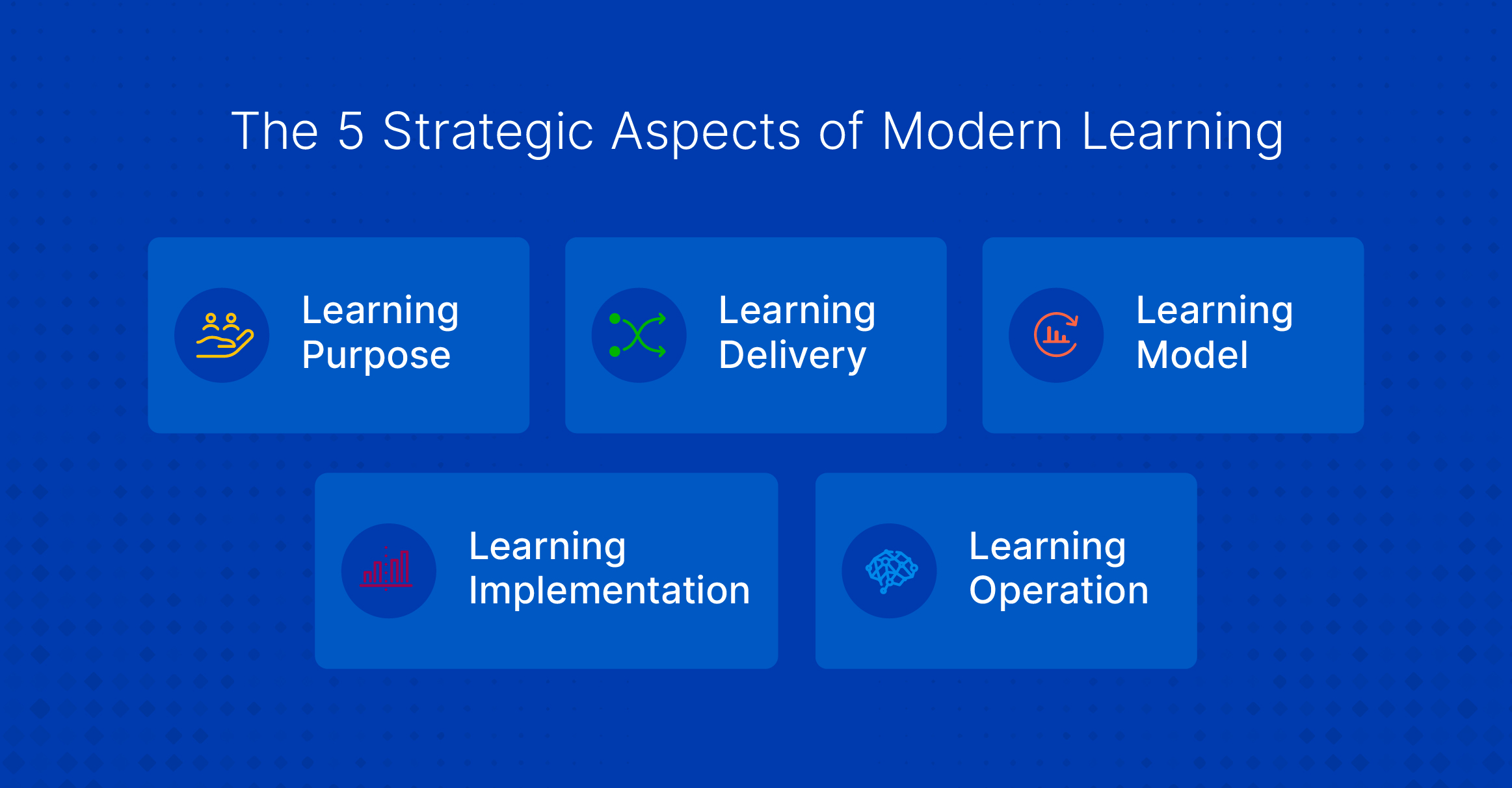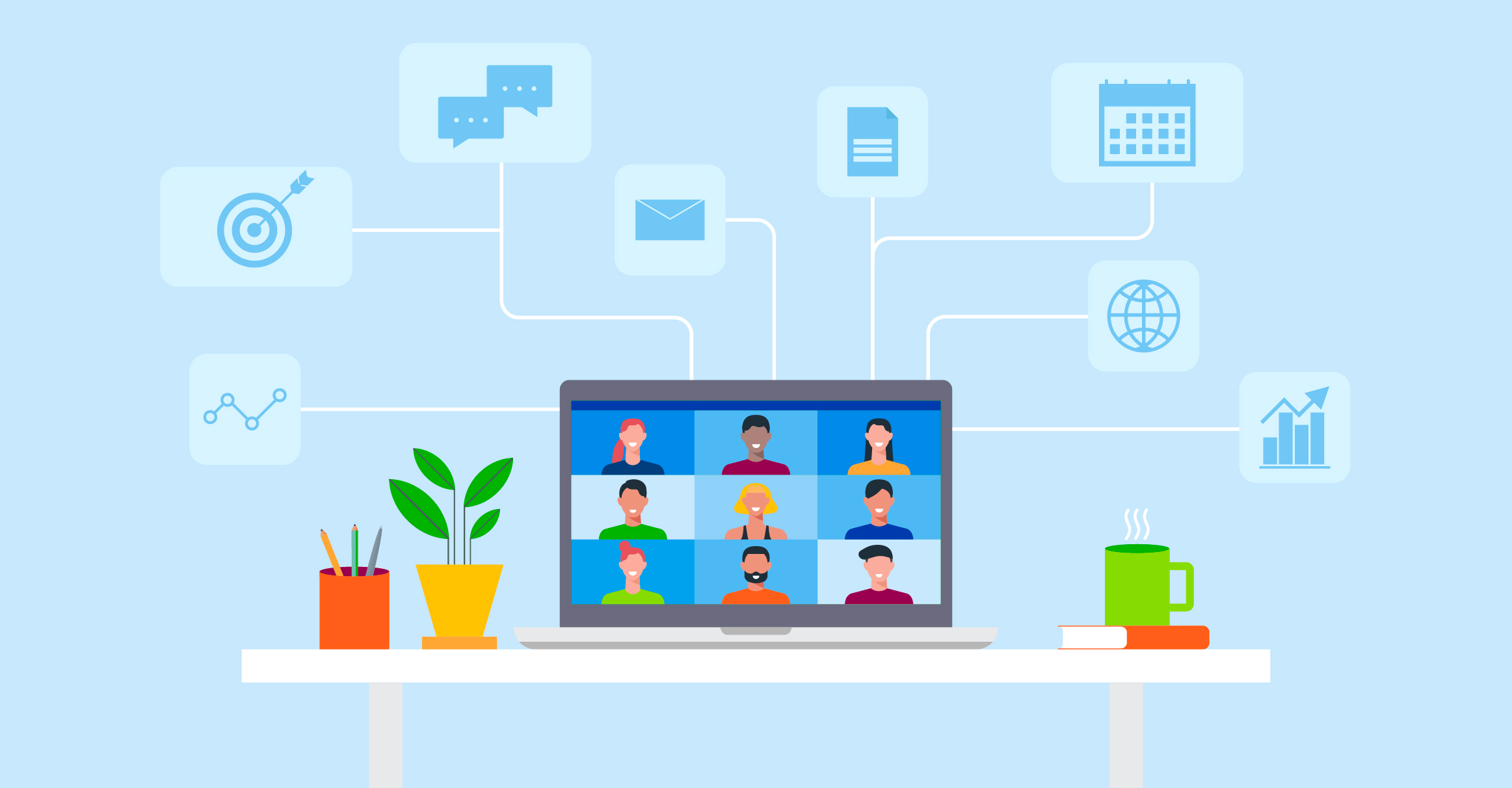Now is the time for learning to be modernized. Business change is accelerating, and agility is key to keeping up with the pace of change. Businesses lacking an agile learning program that empowers busy workers to continuously build skills and perform in quickly evolving roles will be inefficient, poorly trained, and left behind.
Yet traditional learning models are still the norm. These programs are based on traditional long-form courses, virtual and in-person classroom instruction, and content that is not structured to enable job performance or workflow learning. The learning that most companies still settle for today tends to be the “check-the-box” variety that simply notes completion and satisfaction with no insights into actual performance impact. Learning designers still find themselves focused on “one-and-done” courses that provide no ongoing support and are identical for all learners.
Because time available for learning is severely challenged in the modern workplace, new ways to leverage data and intelligence are critical to future success. With the right strategy and technology, modern learning experiences that fit today’s worker, that drive improved outcomes, and that enable learning to align with the business quickly as things change are fully possible.
In this article, we will take a look at what a modern learning strategy looks like and how it can be achieved by bringing personalization and adaptive learning technology into the ecosystem. The following angles will be explored:
-
5 Aspects of Modern Learning Strategy
-
The Foundational Architecture to Enable Modern Learning
-
The Role of Adaptivity and Intelligence
-
Where Organizations are Implementing Adaptive Learning
5 Aspects of a Modern Learning Strategy
To consider what makes a learning strategy modern and built for today’s workplace, it helps to break down the strategy into its components. Five components of a well-thought-out learning strategy include:
-
Learning Purpose - the why of the entire learning operation.
-
Learning Delivery - the way in which learning gets to the learners.
-
Learning Model - how will learners be engaged and how will learning be facilitated.
-
Learning Implementation - the overarching ways learning will be created across all learning needs.
-
Learning Operation - the processes L&D will follow to manage, maintain, and evolve learning content and deliverables.

In a modern learning approach, these components have certain characteristics to support the learning needs of the extremely busy and rapidly changing businesses of today.
Learning’s purpose should be performance-aimed and support the skill-building focus of today’s workplace.
Learning delivery should be individualized, personalized, and available everywhere to support the flexible ways in which people work.
The learning model should be continuously adaptive, responding in real-time to changes in knowledge, engagement levels, and context.
Learning's implementation should provide an integrated, connected, and seamless experience, being available at the point of need in the workflow, not just in the classroom.
The learning operation should provide L&D the agility to pivot and deliver on new requirements quickly through the use of intelligent systems that power automation for efficiency, data-enabled insights to drive fact-based decisions, and always be listening to the learner and the business.
The Foundational Architecture to Enable Modern Learning
The modern learning experience delivered by Realizeit is made possible because of the foundational architecture that the system provides and which complements any learning ecosystem:
-
Individualized learning journeys in the workflow
-
Continuously personalizing and adapting
-
Evidence-based feedback loops
-
Real-time insights and analytics
-
Intelligence and automation for agile learning operations
Individualized learning journeys modernize how learners experience and consume content and knowledge by “un-coursing” the traditional approach. Learning journeys in Realizeit are bite-sized learning experiences that are delivered in guided pathways. The personalized pathway is contextualized to each person in their role, and connects all parts of the learning journey seamlessly across modalities from eLearning to virtual and in-person instruction to one-to-one training to asynchronous discussion groups and more.
Realizeit’s architecture enables continuously personalizing and adapting to:
-
The learner’s context.
-
Their strengths and gaps while building knowledge and competency.
-
The learner’s job performance needs.
-
The learner’s engagement level, giving motivation and nudges when needed.
-
Areas that need reinforcement or that have changed since last learned.
With Realizeit’s evidence-based approach to learning, skills and mastery must be demonstrated through a variety of assessments or captured through external evidence. This ensures learning uptake and enables proper guidance when necessary, and ensures that learning is focused on job performance.
Real-time insights and analytics provide benefits to both learners and managers. Learners receive agency and take ownership over their learning pathway as their strengths and areas of need are visually presented to them on the journey map. Managers are able to deliver personalized support and oversight as analytics are presented to guide their coaching with less effort and greater precision. Additionally, analytics provide L&D insights into what is working and what needs attention in the learning development process, driving learning design that is fact-based.
Intelligence and automation for agile learning operations applies AI to the ongoing work of L&D needed to build and curate meaningful content that aligns with personal skill needs. This includes automatically tagging and understanding content instead of maintaining metadata manually. The process of linking skills, knowledge, and content into ordered learning journeys can be highly automated, and content can be transformed from traditional formats into the granular breakdown required by adaptive learning to personalize learning with AI at scale. Applying intelligence is needed to understand both internal proprietary content and external paid content.
The Role of Adaptivity and Intelligence in Modern Learning
Modern learning is adaptive, but exactly where does adaptivity and intelligence get applied to transform traditional learning into a modern experience?
First, adaptive intelligence contextualizes the experience, the learning journey, and the content to the learner’s role, profile and knowledge level to maximize the relevance to each person.
Adaptive learning speeds up learning by accelerating individuals past their strengths and prior knowledge so they then focus on what they don’t yet know or where they have gaps to fill. This guides learners through the most optimal learning path.
Knowledge reinforcement is a natural part of adaptive learning and helps retain knowledge that is critical. In an adaptive approach, reinforcement focuses automatically on areas of weakness and delivers personalized micro-learning updates.
Adaptive intelligence is also used to craft the right analytics to surface to each role involved in the learning process. This maximizes the impact and value of learning for individuals and groups.
Finally, AI and natural language processing plays a direct role in transforming, indexing, and curating any content. This lets learning designers automatically make sense of a universe of content, while minimizing the effort needed to deliver personalized learning.
Where are organizations implementing adaptive personalized learning?
Adaptive and personalized learning provide value for any learning scenario. Some organizations have a specific area of need where they feel an adaptive approach will make the biggest impact. Typically, this involves one of the top four areas that include:
-
New-hire onboarding
-
Reinforcement and ongoing knowledge maintenance
-
Upskilling and reskilling
-
Compliance or other one-size-fits-all courses that are used on a wide scale where saving time can have a large overall benefit

New-hire onboarding can be more efficient as well as effective and engaging when a modern adaptive approach is applied. The biggest benefit, however, can come from learners feeling appreciated as the learning adapts to their abilities, and they can see they made the right choice in their new organization because the onboarding experience is different from anything they have seen before.
Reinforcement training that adapts will intelligently target the biggest areas of need in a personalized way. The system can continuously assess where each learner’s strengths and weaknesses are and make sure each person gets a tailored reinforcement experience that will engage them and help them close knowledge gaps.
Upskilling and reskilling is the focus of most organizations today as they want to keep employees from looking elsewhere in a tight labor market and help employees reach their fullest potential to better assist the company in reaching its goals. As business shifts and new skills are required, upskilling programs are far less effective without an adaptive system that focuses on competency and efficiency. Learners can get credit for their prior knowledge and build skills more rapidly. Leadership can have a clear picture on how to help employees grow the skills that are vital to the business.
Conclusion: Modern Learning is Adaptive
A modern learning experience that fits today’s worker and positions Learning and Development as a critical part of an agile business strategy depends upon several key factors that are all made possible by aligning a modern learning strategy with the right adaptive learning approach.
Learning that will drive future success is:
With these factors in hand, Realizeit delivers learning experiences that efficiently empower workers to deliver increased productivity and greater business outcomes. We believe that the state-of-the-art in AI-powered adaptivity enables learners to make the best out of the given resources, while at the same time empowering managers and coaches to provide better support in less time. And the learning team that has adaptive learning in their arsenal will have the tools they need to be more agile and align with the business quickly to deliver learning and training that is highly efficient and outcomes focused.
Realizeit will enable you to make learning better with a modern strategy that better engages learners and maximizes the impact of every learning moment.
If you would like to learn more about this topic, watch Manoj Kulkarni, Realizeit CEO, present “Understanding the Business Case for Adaptive Learning” at the Learning Technologies 2023 conference. He will show you the different adaptive learning pathways you can take to achieve success from enterprise adoption to targeting specific use-cases such as onboarding new hires, structured on-the-job training, and continuous skill reinforcement.